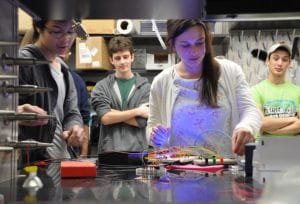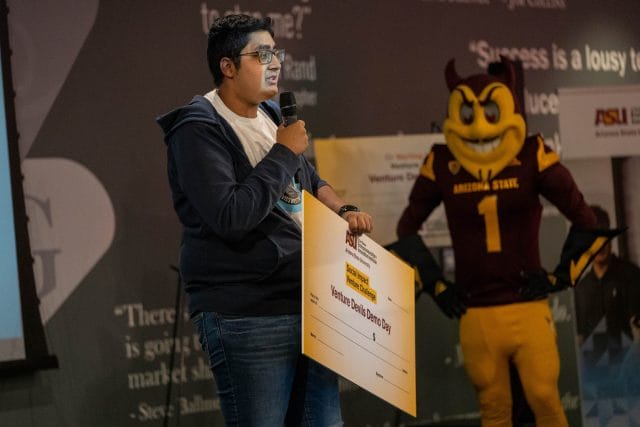There are more entrepreneurship activities and resources available for early-stage innovators than ever before. Yet underrepresentation of women, people of color, and first-generation college students is still present within innovation and entrepreneurship education. How can faculty and entrepreneurial support organizations help cultivate a diverse pipeline of science and technology innovators?
During our OPEN 2018 conference, VentureWell CEO, Phil Weilerstein, spoke with Ji Mi Choi, Associate Vice President of Knowledge Enterprise Development at Arizona State University, about the growing effort to eliminate inequality in innovation and entrepreneurship education. Choi and colleagues from the National Association for Community College Entrepreneurship (NACCE) and Arizona State University led an OPEN panel discussion called Designing for Diversity: Why It Matters and What to Do About It, which explored strategies for increasing participation of historically excluded groups in entrepreneurship. The following excerpt of their conversation highlights ways faculty and entrepreneurial support organizations can help level the playing field for all students interested in innovation and entrepreneurship.
Weilerstein: What are some common barriers preventing underrepresented minority students from participating in innovation and entrepreneurship?
Choi: Perceptual barriers are common. It’s hard to be what you can’t see. Let’s say a underrepresented minority woman is considering a path in technology. However, she constantly sees profiles of white males in that space. How does she connect to a community that doesn’t look like it’s meant for her? That often leads students with great potential to say, “Well, that’s not for me. That’s not who I am.”
Weilerstein: How can universities address that perceptual barrier?
Choi: For starters, audit the marketing materials. Do they reflect the community the institution claims to serve? Several years ago, Arizona State University updated a program page on our entrepreneurship website. Images were chosen for ease, and thought wasn’t given to whether or not they reflected the program mission or community we serve. One image featured 17 men and two women holding a big check from a pitch competition. The women were buried in the picture. I had to really look and find them. I have another example. During a problem-solution exercise in a class, the individuals in the hypothetical scenarios were all men. I finally asked, “By the way, how come it’s a he?”
It’s important to question the images and words used in every touchpoint – from marketing materials and websites to classroom case studies. The same goes for the people representing the institution at events. Get into the habit of asking, “Does this reflect the community we’re serving?”
Weilerstein: How can faculty help their peers adopt inclusion and diversity practices?
Choi: We’re very deliberate about discussing diversity and inclusion with peers, specifically about why diversity matters, and why commitment to inclusive practices is beneficial for everyone. We try to have those conversations regularly – in one-on-one dialogue, in small group settings, and in large conference settings. That’s when these concepts gain traction. I’ve also seen the traction grow when people are celebrated for their progress, such as faculty starting to highlight the successes of the underrepresented minorities in their class.
Weilerstein: Diving a bit deeper into this topic, is it effective when faculty mentor other faculty to change their mindset and behavior around diversity and inclusion?
Choi: Yes. That mentorship often takes the form of a conversation that looks something like this: “Here are the things that I observed, here are some of the things that I tried, here’s what worked, here’s the impact, here’s what you can do.” Faculty are generally open to listen to other faculty, especially if they realize the suggested shifts don’t require an overhaul to a syllabus or significant changes to the classroom setting.
It’s also helpful when faculty share these stories and best practices. They’re learning from one another. It creates a community, where again, it’s not just one person saying, “I’m trying to make these changes on my own.” It becomes a community of faculty who are committed to making a positive impact for the students, institution, and society.
Weilerstein: VentureWell is fully committed to creating and supporting initiatives and programs around inclusive entrepreneurship. And we’re always working to do it better. In your opinion, how can entrepreneurial support organizations effectively embrace inclusive entrepreneurship in their work?
Choi: There are many ways entrepreneurial support organizations can embrace inclusive entrepreneurship. Take the VentureWell OPEN conference. The topic of inclusive entrepreneurship is well-represented in the programming. That not only elevates the issue within the community, it offers ample opportunities for faculty, practitioners, and leaders to have conversations and develop action plans around diversity and inclusion on their campus. In addition to giving the topic prominence during the conference, the presenters are diverse in terms of ethnicity, socioeconomic backgrounds, and gender. They more accurately reflect the network.
The more entrepreneurship support organizations can engage in dialogues around this topic – and invite a diverse group of people to the conversation – the closer we’ll be to creating more opportunities for all of tomorrow’s inventor-entrepreneurs.
Underrepresentation in innovation and entrepreneurship prevents the full engagement of everyone who has the potential to solve the world’s most complex challenges. Faculty and entrepreneurial support organizations are well-positioned to help provide more seats at the innovation and entrepreneurship table.
Watch an excerpt of Weilerstein and Choi’s conversation about eliminating inequality in innovation and entrepreneurship education here.
Article courtesy of VentureWell


